
Silk Road Trade & Travel Encyclopedia
丝绸之路网站(丝路网站)
丝绸之路百科全书—游客、学生和教师的参考资源
İPEK YOLU ve YOLLARI ANSİKLOPEDİSİ
www.ipekyollari.net

Silk Road Trade & Travel Encyclopedia
丝绸之路网站(丝路网站)
丝绸之路百科全书—游客、学生和教师的参考资源
İPEK YOLU
ve YOLLARI
ANSİKLOPEDİSİ
www.ipekyollari.net
H
A B
C
D
E
F
G
H I
J
K
L
M
N O P
Q
R
S
T
U V
W
X
Y
Z
Hacip
Yusuf Has Hacip (or Yusuf Khas Hajib) (See Kutadgu Bilig)
Hamadan (Hamedan, Ecbatana) is believed to be among the oldest Iranian cities and one of the oldest in the world. According to an inscription from the first Assyrian king, Hamadan's construction is dated at 1100 BC, but some historians believe it dates back to 3000 BC. Hamadan was established by the Medes and was the capital of the Median empire. It then became one of several capital cities of the Achaemenid Dynasty. Hamadan stands on the Silk Road, and even in recent centuries the city enjoyed strong commerce and trade as a result of its location on the main road network in the western region of Iran. More...
Hamam Multi-domed bathhouses (often found at roadside inns, called Caravanserais," where travelers and caravans rested).
Hamidiye was a large trading city, like Aleppo, located in Syria at the western end of the Silk Road.
Hami (Kumul, Komul, Kunwu) City located in the northern end of Xinjiang Uygur Autonomous Region, neighboring Gansu Province in the east, and the Inner Mongolia Autonomous Region in the south. It shares a 587 kilometers (365 miles) boundary with Mongolia.
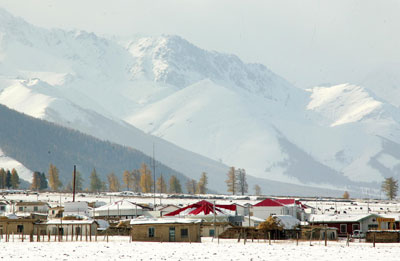
Hami, as the eastern gate of Xinjiang, was an important town on the northern route of the ancient Silk Road. Within its territory are many beacon towers, ancient cities, tombs, stone tablets and rock carvings. The purpose of beacon towers along the Silk Road was to form, together with the Great Wall, a complete defense system. At times of threat, beacons were lit to sound the alarm. Beacon towers still stand along the northern and central routes of the Silk Road, north and south of the Tianshan Mountains, 51 of them in Hami.
Hami King's Mausoleum is the tomb of Hami King Hui III, in Hami Xinjiang, China. The mausoleum is covered with green glazed and white patterned tiles. Near the mausoleum is a large mosque, whose interior contains carved wooden pillars, and painted flower patterns with verses from the Koran. (See Islamic King's Tomb)
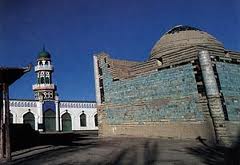
Han Dynasty The Central Asian sections of the Silk Routes were expanded around 138 BCE by China's Han Dynasty, largely through the missions and explorations of Zhang Qian. The capital of the Han Dynasty was Chang'an (modern-day Xian), the starting point of the famed Silk Road.
The Han Dynasty in 87 BC
(click to see commanderies shown in red dots, and protectorates in green
dots)
The Han Empire (202 BC–AD 220) was divided into areas directly controlled by the central government, known as commanderies, and a number of semi-autonomous kingdoms. These kingdoms gradually lost all vestiges of their independence, particularly following the Rebellion of the Seven States. The Xiongnu, a nomadic confederation which dominated the eastern Eurasian Steppe, defeated the Han army in battle in 200 BCE. Following the defeat, a political marriage alliance was negotiated in which the Han became the de facto inferior partner. When, despite the treaty, the Xiongnu continued to raid Han borders, Emperor Wu of Han (r. 141–87 BCE) launched several military campaigns against them. The Sino-Xiongnu War is a name given to a series of battles between the Han Dynasty and the tribes of Xiongnu between 133 BC and 89 AD. The ultimate Han victory in these wars eventually forced the Xiongnu to accept vassal status as Han tributaries. These campaigns expanded Han sovereignty into the Tarim Basin of Central Asia and helped establish the vast trade network known as the Silk Road, which reached as far as the Mediterranean. Han forces managed to divide the Xiongnu into two competing nations, the Southern and Northern Xiongnu, and forced the Northern Xiongnu across the Ili River. Despite these victories, the territories north of Han's borders were quickly overrun by the nomadic Xianbei Confederation. More...
Hangzhou was a Chinese city taken by the Mongols in 1276 and became a source of wonder for Marco Polo, who had never seen a city as large and sophisticated. In the 13th century, Marco Polo praised Hangzhou as the most beautiful city in the world, a city famous for its silk and tea products. According to Marco Polo, he visited Hangzhou some time after 1276, when the Mongols under Bayan had captured it on behalf of Kublai Khan. Hangzhou, a city at the end of a large bay about 100 miles southwest of modern Shanghai, had been the capital of the Southern Song Dynasty (1127-1280).
Hanseatic League (also known as the Hanse or Hansa) was an economic alliance of trading cities and their guilds that dominated trade along the coast of Northern Europe in the later Middle Ages. At the height of its power in the late 14th century, the merchants of the Hanseatic League succeeded in using their economic clout and sometimes their military might—trade routes needed protecting and the League's ships sailed well-armed. More...
Hayton I (Hethum or Haithon 1254-1255) and Kirakos Gandsaketsi King of Little Armenia, Hayton traveled through the Caucasus and territories of Khan Batu to the Great Khan Möngke in Karakorum and then back via Samarkand, Bukhara and Tabriz. The account of his travels was written down by Kirakos, who accompanied Hayton (a descriptive narrative of the Near East was written by Hayton's nephew of the same name).
He
Zheng He
a famous Muslim navigator during the Ming dynasty.
Zheng He (Hajji Mahmud Shams, 1371–1435) was a
Hui
Chinese mariner,
explorer,
diplomat
and
fleet admiral, who commanded voyages to Southeast Asia, South Asia, and East
Africa. He was the great great great grandson of
Sayyid Ajjal Shams al-Din Omar, a
Persian who served in the administration of the
Mongolian Empire and was appointed governor of
Yunnan during
the early
Yuan
Dynasty. Between 1405 and 1433, the Ming government sponsored a series of
seven naval expeditions, one of the best known in 1421. The Yongle emperor designed them to establish a Chinese
presence, impose imperial control over trade, and impress foreign peoples in the
Indian Ocean basin. Zheng He was placed as the admiral in control of the huge
fleet and armed forces. He is known to have brought back to China exotic animals
from Africa, such as lions, oryxes, nilganias, zebras and ostriches.
Fei Xin, who also traveled on ship, wrote about the Chinese expeditions of Admiral Zheng He in about 1436. Accounts contemporary to Zheng He's era which indicate he was a Chinese Muslim explorer include the writings of Ma Huan, Zheng He's chronicler, interpreter, and fellow Muslim, who travelled with him on many of his voyages. The documentation of Ma Huan is considered a first hand account by a classically trained Chinese-Muslim diplomat who traveled with the Ming Treasure Fleet in the early 15th century. A "Treasure ship" (Chinese: 宝船) is the name for a type of large wooden vessel commanded by the Chinese admiral Zheng He on seven voyages in the early 15th century in Ming Dynasty. (See also Jingjue and Huajue Mosque) Map More...
Heavenly Lake (Lake Tianchi) near Urumqi, in Tianshan Tianchi National Park, presents visitors with the remarkable landscape of Xinjiang, which also is home to barren desserts, as well as the snowy Tianshan Mountains. More...
Hedin
Sven Hedin (1865-1952) was a Swedish
geographer,
topographer,
explorer,
photographer,
and travel writer, as well as an illustrator
of his own works. During his expeditions to Central
Asia he discovered the Transhimalaya
and the sources of the Brahmaputra,
Indus
and Sutlej
Rivers, Lake Lop
Nur, and the remains of cities, grave sites and the Great
Wall of China in the deserts of the Tarim
Basin. The posthumous publication of his Central Asia atlas marked
the conclusion of his life’s work. Hedin's expedition notes laid the
foundations for a precise mapping of Central Asia. He was one of the first
European scientific explorers to use native-born scientists and research
assistants on his expeditions. In three expeditions along the Silk Routes and
through the mountains and deserts of Central Asia (1894 and 1908), he mapped and
researched parts of Xinjiang
and Tibet which
had been unexplored until then. See IDP
More...
Henan Although the Chinese section of the Silk Road (which began in the city of Xi'an) has focused on the 5 provinces of Shaanxi, Gansu, Ningxia, Qinghai, and Xinjiang, the eastern province of Henan (in green to the right) also has historic sites which have been associated with the Silk Road. (See UNESCO)
| Gongyi Stone Cave Temple - Luoyang City |
|
| Luoyang city of Han and Wei Dynasties - Luoyang City | |
| Luoyang City of the Sui and Tang Dynasties - Luoyang City | |
| White Horse Temple - Luoyang City: | |
| Han'gu Pass and Xiaohan Ancient Path in Han Dynasty |
Henry "the Navigator" was a prince of the Kingdom of Portugal and an important figure in the early days of the Portuguese Empire. He was responsible for the early development of European exploration and maritime trade routes with other continents. He sponsored expeditions of discovery in the Atlantic Ocean, and down the western coast of Africa. Prince Henry never actually sailed on any of the voyages of discovery he sponsored. Instead, he established a school for the study of the arts of navigation, mapmaking, and shipbuilding, which enabled improved designs and better guidance for ships. Prince Henry's goal was to find a route to the rich spice trade of the Indies, while exploring the west coast of Africa. The ships that sailed the Mediterranean were slow and too heavy to make these voyages. Under his direction, a new and lighter ship was developed, the caravel, which allowed sea captains to sail further and faster.
Having developed the lateen-rigged caravel, it was the Portuguese who led the way of maritime expansion as Europeans sought alternative routes to Asia. Due to the Mongol Peace (Pax Mongolica) during the Mongol-Yuan Empire, Europeans had long enjoyed a safe land passage along the Silk Routes to China and India, which were sources of valuable goods. The maritime expansion of Portugal was the result of the threat to Mediterranean commerce that had developed very rapidly after the crusades, especially the trade in spices. Spices traveled by various overland routes from Asia to the Levant, where they were loaded aboard Genoese and Venetian ships and brought to Europe. Portuguese navigators, under the leadership of King John II, sought to reach Asia by sailing around Africa. Major progress in this quest was achieved in 1488, when Bartolomeu Dias reached the Cape of Good Hope, in what is now South Africa. More...
Hentii northeast of Ulaanbaatar, Mongolia, is the homeland of Chinggis Khaan, where a 40 meter high Genghis Khan Equestrian Statue can be found in his honor - the largest equestrian statue in the world. This is considered the Heartland of Mongolia, near the Onon River Valley, and is the birthplace of Chinggis Khaan, or Temujin. More...
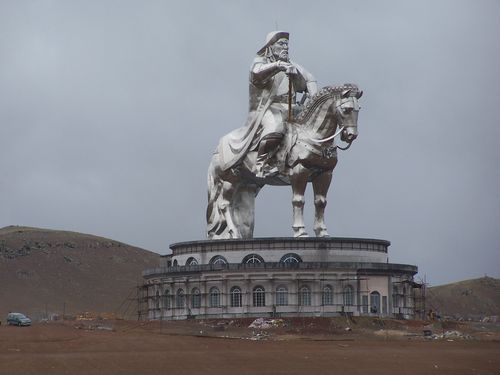
Hephthalites Although the Hephthalites dominated much of Central Asia and Northern India at the height of their power (approximately 460 to 570), little information about their civilization is available. Historians tend to fall into two camps when discussing Hephthalite origins. One theory is that the Hephthalites were once part of the Juan-juan confederacy of Turkic nomadic peoples (there are similarities in portraiture found on Hephthalite and Yuezhi coins). This suggests evidence of a common Western China homeland for both these cultures. An alternate explanation put forth by Kazuo Enoki in the 1950s is that the Hephthalites were an Iranian group who settled in the Altai region, from where they began their military expansion south into the Bactrian region. Although their origins are not clear, by the year 500 branch empires of the Hephthalites controlled an area stretching south from Transoxiana to the Arabian Sea, and as far west as Khurasan (the eastern-most part of the Sassanian empire), and all of northern India to the east.
Herat Situated in a fertile area, Herat is nearly 3,000 years old. The city has many historic buildings, although they have suffered damage in various military conflicts during the last few decades. Herat is dominated by the remains of a citadel constructed by Alexander the Great. During the Middle Ages Herat became one of the important cities of Khorasan, and was known as the "Pearl of Khorasan." The city lies on the ancient trade routes of the Middle East, Central and South Asia. The roads from Herat to Iran, Turkmenistan, and other parts of the country are still strategically important. Herat is the third largest city of Afghanistan. More...
Hexi (Gansu) Corridor Historically the only route from central China to western China and the rest of Central Asia. Bordered on all sides by inhospitable mountains and desert, the Hexi Corridor was the principle link between northern China, the Tarim Basin, and Central Asia. Traders and military forces used this important route which connected with a string of oases. By 115 BC, the Chinese succeeded in driving out hostile nomads (sometimes referred to as Barbarians) from the Gansu corridor. This fertile valley of oasis towns gave rise to crops of precious rhubarb, a plant indigenous to the region. In the seventeenth century, Russia’s “Rhubharb Road” imported the medicinal plant from the Hexi Corridor to the Central Apothecary Office in St. Petersburg. Rhubarb (a natural laxative) also was supplied to Europe and the British during the mid-nineteenth-century opium wars. (See Zhangye) More...
Hindu Kush is a 500-mile mountain range stretching between north-western Pakistan and eastern and central Afghanistan. The highest point in the Hindu Kush is Tirich Mir (7,708 m or 25,289 ft) in the Chitral region of the Khyber-Pakhtunkhwa Province of Pakistan. It is the westernmost extension of the Pamir Mountains, the Karakoram Range, and is a sub-range of the Himalayas.
Hongwu (See Wu)
Hopkirk
Peter Hopkirk In his famous book "Foreign Devils on the Silk Road: The
Search for the Lost Treasures of Central Asia," Hopkirk tells the story of the
men who led archaeological raids of ancient Silk Road cities. What are described
as "foreign explorers" from the West, not only made historic discoveries, but
also took enormous quantities of wall-paintings, sculptures, manuscripts, and
other treasures from China and the ancient cities of the Silk Routes.
Hordes In the West, a horde was any major grouping of Mongols, including the Golden Horde, with its various sub-hordes. The word "Horde" derives from the Mongolian "hordo," or "ordo," meaning "palace tent."
Horses like other pack animals, such as camels, were used as tributes and in the exchange of gifts, in addition to being valued for military and imperial uses. Turkic peoples of Central Asia revered their horses. Since thousands of years, the Akhal-Teke horses, have been honored by the peoples of Asia. Archeological excavations in Turkmenistan and in high elevation frozen graves in the Pazyryk kurgans have uncovered remains of horses believed to be related to the Akhal-Teke, buried with their masters at the time of the Scythians. Horses have been used in warfare for over 5,000 years.
Hotan is an oasis town lying in the Tarim Basin, just north of the Kunlun Mountains, which are crossed by the Sanju Pass, and the Hindu-tagh, and Ilchi passes. The town, located southeast of Yarkand, is in the Xinjiang Uyghur Autonomous Region of China in the Tarim Basin. Hotan is strategically located at the junction of the southern (and most ancient) branch of the famous “Silk Route” joining China and the West with one of the main routes from ancient India and Tibet to Central Asia and distant China. It provided a convenient meeting place where not only goods, but technologies, philosophies, and religions were transmitted from one culture to another. This agricultural town is populated mostly by Uyghurs. An important station on the southern branch of the historic Silk Road, Hotan has always depended on two strong rivers - the Karakash River and the Yurungkash River (the Black and White Jade rivers respectively) to provide the water needed to survive on the southwestern edge of the vast Taklamakan Desert. Hotan is 36 km east of the Zam Grottoes, and 20 km south of the ruins of Rawak. (See also Kingdom of Khotan) More...
Hoton Jade Hotan for centuries has been famous for its jade, which is now mined in the Kunlun Mountains. Because this precious stone was previously inaccessible, lumps of rough jade, which were carried down by torrents of water, were eagerly sought. The Jade of Hoton has been greatly valued since ancient times. Centuries before the "Silk Road" became popular with traders, jade was introduced to the central part of China along what has been called the ancient "Jade Road," and was treasured by feudal emperors as a valued tribute from the western region.
Hsiung-nu Empire (Xiongnu or Xiung-nu, pronounced SHE-UNG-NU) The Hsiung-nu were a confederation of nomadic tribes whose ethnic identity has been a subject of varied hypotheses (often referred to as Turkic-Mongolic, or "the Huns"). The Hsiung-nu established a great empire under the reign of Mete Khan (late 3rd century BC – 2nd century AD). The tribal confederation of Hsiung-nu was the first nomadic empire in Central Asia. Located near China's northwest border, the Hsiung-nu often raided and posed a threat to the Chinese frontier. The Chinese written tradition traces the beginnings of the Hsiung-nu back to times immemorial, and early Chinese sources identify the Hsiung-nu as Hu.. It is reported that the Hsiung-nu had been known in remote antiquity under a number of different names, such as Hun-chu, Hsien-yün, and Jung, Ti. Early Chinese sources describe how China defended itself against the Hsiung-nu (even before the Hsiung-nu's attempted armed incursions into China). Historians have often referred to the Hsiung-nu as Turkic-Mongolic, or "the Huns."
There are no reliable accounts of the Hsiung-nu much beyond the 3rd century B.C. The Hsiung-nu were documented in Chinese history during the end of the Warring States period. There is documentation from early Chinese sources about how China defended itself against the Hsiung-nu before they actually encountered Hsiung-nu armed incursions into China. In the late Warring States period three major states, Ch'in, Chao, and Yen, were all southern neighbors of the Hsiung-nu, and each as a defense against the nomads built a wall along its northern border. Of the three, Ch'in was the first to do so (not later than 324 B.C.), however its entire walled defense system - in Lung-hsi (Kansu), Pei-ti (parts of Kansu and Ninghsia), and the Shang Commandery (parts of Shensi and Suiyuan) – was not completed until around 270 B.C. The northern border wall of Chao was built afterwards, stretching from Yün-chung (in Suiyuan) through Yen-men to Tai (both in Shansi), and was built around 300. (See Hsiung-nu Empire, or Xiongnu)
Hu From the earliest historical records, the Chinese spoke of nomads in modern-day Mongolia and referred to them as "Hu," and to others as Xiongnu. These nomadic groups were well known to the Chinese for they often raided northern kingdoms. After successfully uniting, these nomadic tribes created the first powerful Central Asian state of Hunnu under the legendary Modu Shanyu, c. 209 BCE. Also known as Mete Han, he was the fourth known king and founder of the Xiongnu Empire. After unifying the tribes of the Mongolian steppes, the united Hu posed an imminent threat to the Chinese Qin Dynasty -- for the Xiongnu Empire was the largest of the time - the eastern border stretched as far as the Liao River, the western borders of the empire reached the Pamir Mountains, while the northern border reached Lake Baikal. To better understand the empires and khanates that emerged out of the fringes of today's Mongolia, one must examine the rise of the: Xianbei Empire, 2-5th centuries; Rouran Empire, 5-6th centuries; Turkic Khanate, 6-8th centuries; Uyghur Khaganate, 8-9th centuries; Kyrgyz period, 9-11th centuries; Khitan Empire, 10-12th centuries; and the Mongol Empire, 13-14th centuries.
Hui (Hu) Turkic peoples who lived in what is now western China. The nomadic horse-riders of the northern steppes are first mentioned in fourth century BCE Chinese historical records, and were given the name "Hu," a word derived from Chinese. By third century BCE the Hu had developed a sophisticated bronze-age culture. Bone artifacts etched with drawings demonstrate that the Hu used chariots, bow and arrow, and hunted with dogs. Their interest in trading with the southern Chinese kingdoms is known from such artifacts. Furthermore, Hu objects (such as a dagger decorated with a ram's head) have been discovered in archaeological digs in Xia and Shang cultural sites, indicating trade (or at least exchange of goods and technology).
Many historians generalize the Hu as a loosely associated confederation of nomadic peoples, rather than a single, unified culture. Similar cultural patterns between the Hu and other nomadic peoples in Eastern and Central Asia, such as the Sakas, have led some scholars to theorize a common origin for all nomads of the Eurasian steppes. Textual evidence is also extant, such as Herodotus' mention of an Asian homeland for the Scythians, as the Sakas were known to the Greeks. Linguistic differences aside, at the very least similar social organization and leadership systems, similar artistic styles, similar ornamental horse coverings, and weapons point to a long history of cultural and material exchange between Central and East Asian nomadic peoples prior to the fourth century BCE. (See Ningxia Hui Autonomous Region)
Note: Some scholars point out that it is a common misconception that the Great Wall was originally created in defense against raiders from the north and east, such as the Eastern Hu. In fact, the Great Wall was not conceived to serve a military function until the Qin dynasty, when sections were added to existing walls. Prior to the Qin, states had long practiced the construction of walls to delineate political boundaries. It was due to Hu incursions during the Qin Dynasty that the northern-most barrier was fortified, and thus the wall began to serve more of a military function, rather than a political function.
Huajue Mosque "The Great Mosque of Xi'an" (Huajue Mosque 西安大清真寺) is the oldest and one of the most renowned and largest mosques in China, founded in 742. It is located near the Ming Dynasty Drum Tower (西安鼓楼, built 1380), which along with the Bell Tower is a symbol of the city. Unlike most mosques in the Middle East, the Great Mosque of Xi'an is Chinese in its architectural style, for the mosque has neither domes nor traditional-style minarets. The Huajue Mosque denotes the Islamic presence in Xian and is still used today as a place of worship by Muslims.

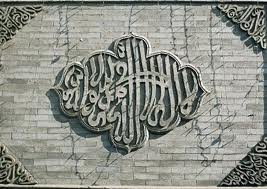
Chinese architecture combines with Islamic decorative art and culture.
Muslims here in China have long enjoyed a close relationship with Muslims in other parts of China and abroad. Huajue Mosque in Xi'an was ordered to be built together with the Jingjue Mosque in Nanjing by Emperor Hongwu during the Ming dynasty (c.1392) after Zheng He (a famous Muslim navigator and traveler) asked for the emperor's permission to rebuild the mosque in Nanjing. The Jingjue Mosque was repaired by the end of his seventh journey. In 1405, the Sultan of Brunei along with his family and chamberlains visited China, however passed away in Nanjing. The Sultan was buried in the southern outskirts of the city, where to this day his burial grounds can be seen. Jingjue mosque is one of the eight famous mosques in the southeast coastlands of China.
Huan
Ma Huan Muslim interpreter who accompanied the famous Ming admiral
Ch'eng Ho (Zheng He) on his fourth, sixth and seventh expeditions to the Indian
Ocean. His Ying-yai sheng-lan (Overall Survey of the Ocean's Shores, published
in 1451) contains valuable information on geography, products and trade in
Southeast Asia, South Asia, and the Middle East. On the first two voyages, he
went as far as Hormuz; on the third he apparently reached Mecca.
Hui are an ethnic group in China, distinguished by their practice of Islam. Many are direct descendants of Silk Road travelers. Besides the Hui people, there are other officially recognized ethnic groups that are considered predominantly Muslim. Those groups are defined mainly on linguistic grounds: namely, six groups speaking Turkic languages ( Uyghurs, Kazakhs, Kyrgyz, Salars, Uzbeks, and Tatars), two Mongolian-speaking groups (Dongxiang and Bonan), and one Iranian-speaking group (Tajiks). More...
Huns The Huns were a group of Eurasian nomadic pastoral people who, appearing from beyond the Volga, who migrated into Europe c. AD 370 and built an immense empire. They were possibly the descendants of the Xiongnu who had been northern neighbors of China 300 hundred years earlier to the emergence of the Huns, and may be the first expansion of Turkic people across Eurasia. The origin and language of the Huns has been the subject of debate for centuries. According to some theories, their leaders at least may have spoken a Turkic language.
The French Orientalist and sinologist De Guignes linked them with the Xiongnu (assumed to be Mongolic-Turkic).Considerable scholarly effort has been devoted in investigating such a connection, however, there is no evidence for a direct connection between the Xiongnu and the Huns. Very little evidence has survived of the language of the Huns, and their ethnic identity has been a subject of debate for centuries. According to many theories, it was a Turkic language. Nor can the Huns be ascribed a territory of origin. The Steppe region of Russia, and further east, is generally referred to as the homeland of the Huns. The most famous of the Huns is "Attila the Hun" (the ruler of the Huns from 434 until his death in 453). Attila was leader of the Hunnic Empire, which stretched from Germany to the Ural River and from the Danube River to the Baltic Sea. More...
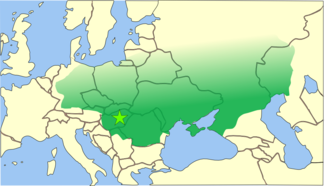
The Western
Hun Empire stretched from the steppes of
Central Asia into Hungary and modern Germany,
and from the
Black Sea to the
Baltic Sea.
Hwai
Du Hwai was a Chinese soldier defeated and imprisoned by the Arabs at the
famous Battle of Talas in 751. After ten years in prison he traveled to
Tashkent, Samarkand, passing northern Iran to Iraq, and west into Syria. On the
Persian Gulf, he boarded a ship, returned to Canton via the Indian Ocean and
South China Sea. His book is a personal account of the Battle of Talas and his
prison life in Central Asia.
Silk Routes.net | Ipek Yollari.net